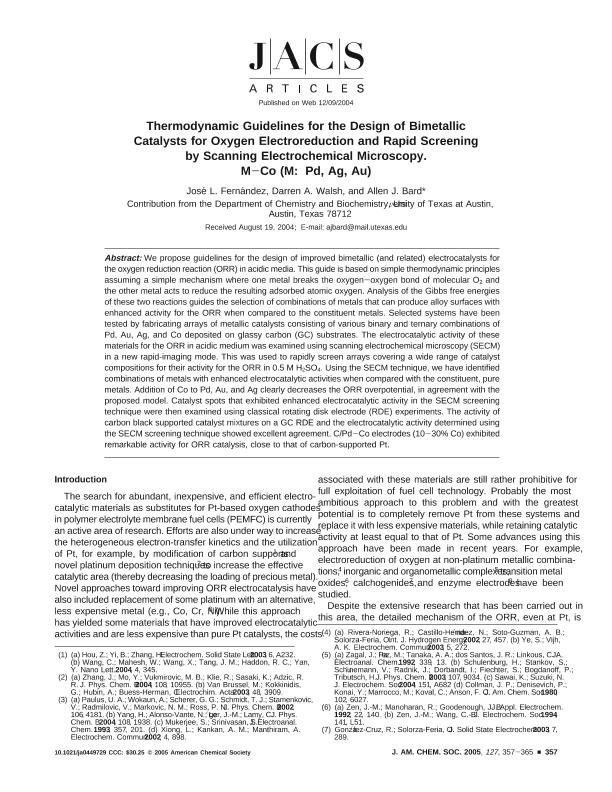Mostrar el registro sencillo del ítem
dc.contributor.author
Fernandez, Jose Luis

dc.contributor.author
Walsh, Darren A.
dc.contributor.author
Bard, Allen J.
dc.date.available
2020-04-14T21:07:11Z
dc.date.issued
2005-01
dc.identifier.citation
Fernandez, Jose Luis; Walsh, Darren A.; Bard, Allen J.; Thermodynamic Guidelines for the Design of Bimetallic Catalysts for Oxygen Electroreduction and Rapid Screening by Scanning Electrochemical Microscopy. M−Co (M: Pd, Ag, Au); American Chemical Society; Journal of the American Chemical Society; 127; 1; 1-2005; 357-365
dc.identifier.issn
0002-7863
dc.identifier.uri
http://hdl.handle.net/11336/102572
dc.description.abstract
We propose guidelines for the design of improved bimetallic (and related) electrocatalysts for the oxygen reduction reaction (ORR) in acidic media. This guide is based on simple thermodynamic principles assuming a simple mechanism where one metal breaks the oxygen-oxygen bond of molecular O2 and the other metal acts to reduce the resulting adsorbed atomic oxygen. Analysis of the Gibbs free energies of these two reactions guides the selection of combinations of metals that can produce alloy surfaces with enhanced activity for the ORR when compared to the constituent metals. Selected systems have been tested by fabricating arrays of metallic catalysts consisting of various binary and ternary combinations of Pd, Au, Ag and Co deposited on glassy carbon (GC) substrates. The electrocatalytic activity of these materials for the ORR in acidic medium was examined using scanning electrochemical microscopy (SECM) in a new rapid-imaging mode. This was used to rapidly screen arrays covering a wide range of catalyst compositions for their activity for the ORR in 0.5 M H2SO4. Using the SECM technique, we have identified combinations of metals with enhanced electrocatalytic activities when compared with the constituent, pure metals. Addition of Co to Pd, Au and Ag clearly decreases the ORR overpotential, in agreement with the proposed model. Catalyst spots that exhibited enhanced electrocatalytic activity in the SECM screening technique were then examined using classical rotating disk electrode (RDE) experiments. The activity of carbon black supported catalyst mixtures on a GC RDE and the electrocatalytic activity determined using the SECM screening technique showed excellent agreement. C/Pd-Co electrodes (10-30% Co) exhibited remarkable activity for ORR catalysis, close to that of carbon-supported Pt.
dc.format
application/pdf
dc.language.iso
eng
dc.publisher
American Chemical Society

dc.rights
info:eu-repo/semantics/openAccess
dc.rights.uri
https://creativecommons.org/licenses/by-nc-sa/2.5/ar/
dc.subject
Bimetallic Catalysts
dc.subject
Oxygen Electroreduction
dc.subject.classification
Físico-Química, Ciencia de los Polímeros, Electroquímica

dc.subject.classification
Ciencias Químicas

dc.subject.classification
CIENCIAS NATURALES Y EXACTAS

dc.title
Thermodynamic Guidelines for the Design of Bimetallic Catalysts for Oxygen Electroreduction and Rapid Screening by Scanning Electrochemical Microscopy. M−Co (M: Pd, Ag, Au)
dc.type
info:eu-repo/semantics/article
dc.type
info:ar-repo/semantics/artículo
dc.type
info:eu-repo/semantics/publishedVersion
dc.date.updated
2020-04-13T13:17:44Z
dc.journal.volume
127
dc.journal.number
1
dc.journal.pagination
357-365
dc.journal.pais
Estados Unidos

dc.description.fil
Fil: Fernandez, Jose Luis. Universidad Nacional del Litoral. Facultad de Ingeniería Química. Programa de Electroquímica Aplicada e Ingeniería Electroquímica; Argentina
dc.description.fil
Fil: Walsh, Darren A.. University of Texas at Austin; Estados Unidos
dc.description.fil
Fil: Bard, Allen J.. University of Texas at Austin; Estados Unidos
dc.journal.title
Journal of the American Chemical Society

dc.relation.alternativeid
info:eu-repo/semantics/altIdentifier/doi/http://dx.doi.org/10.1021/ja0449729
Archivos asociados
